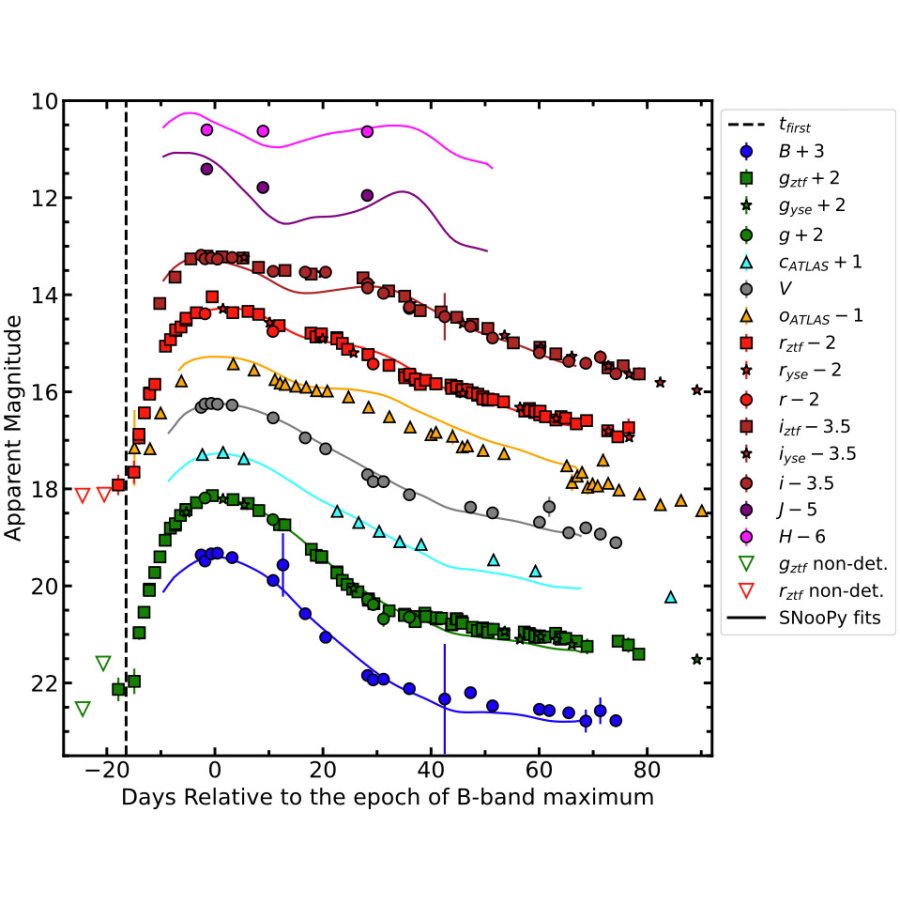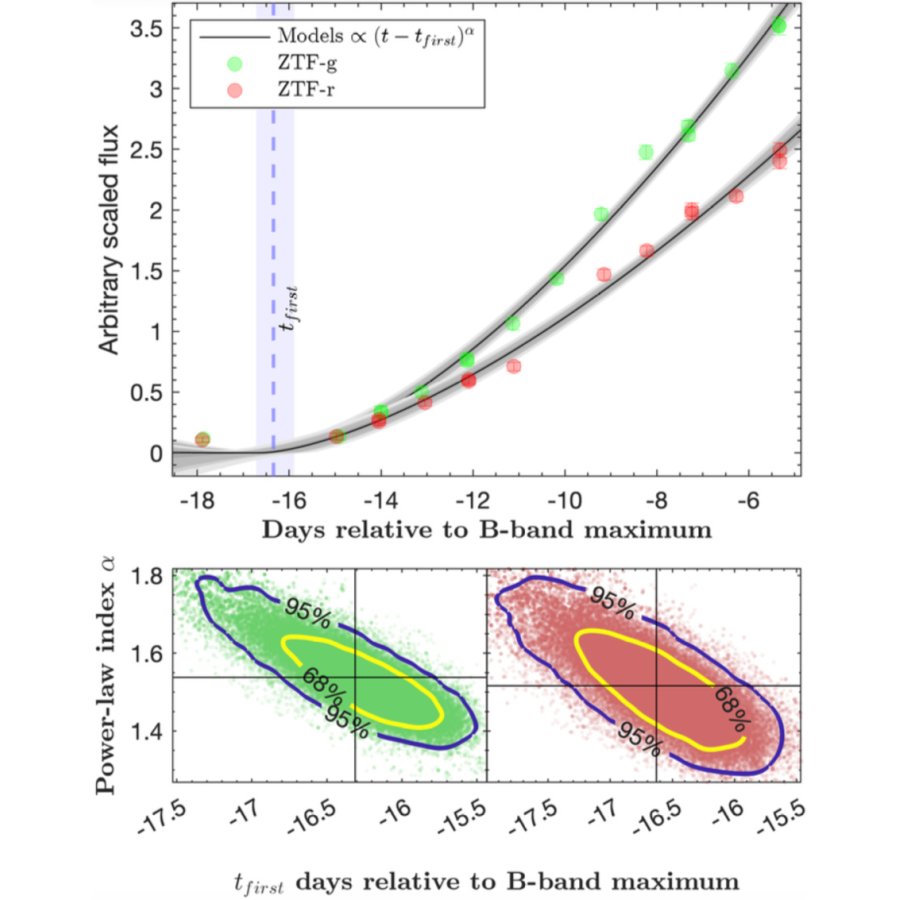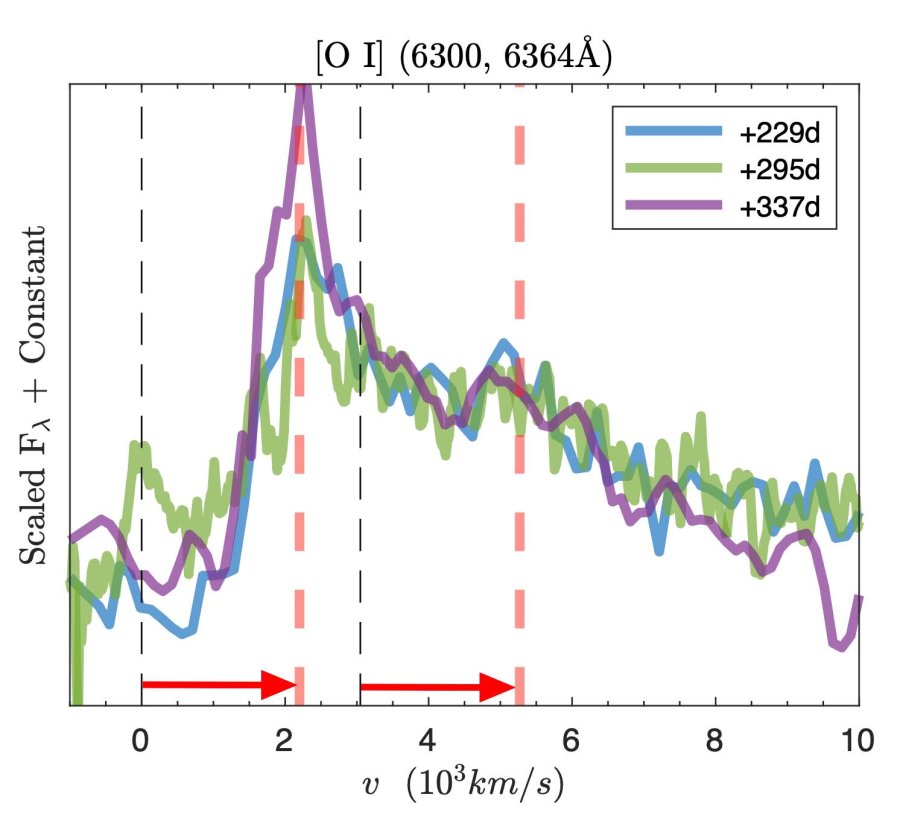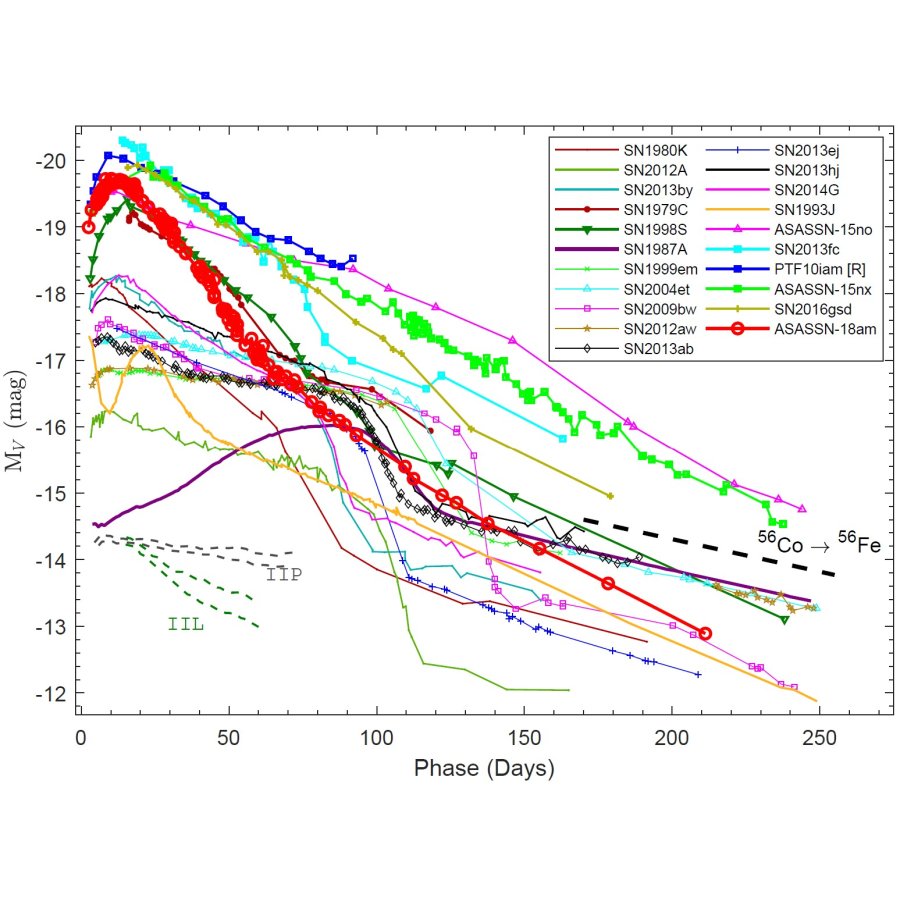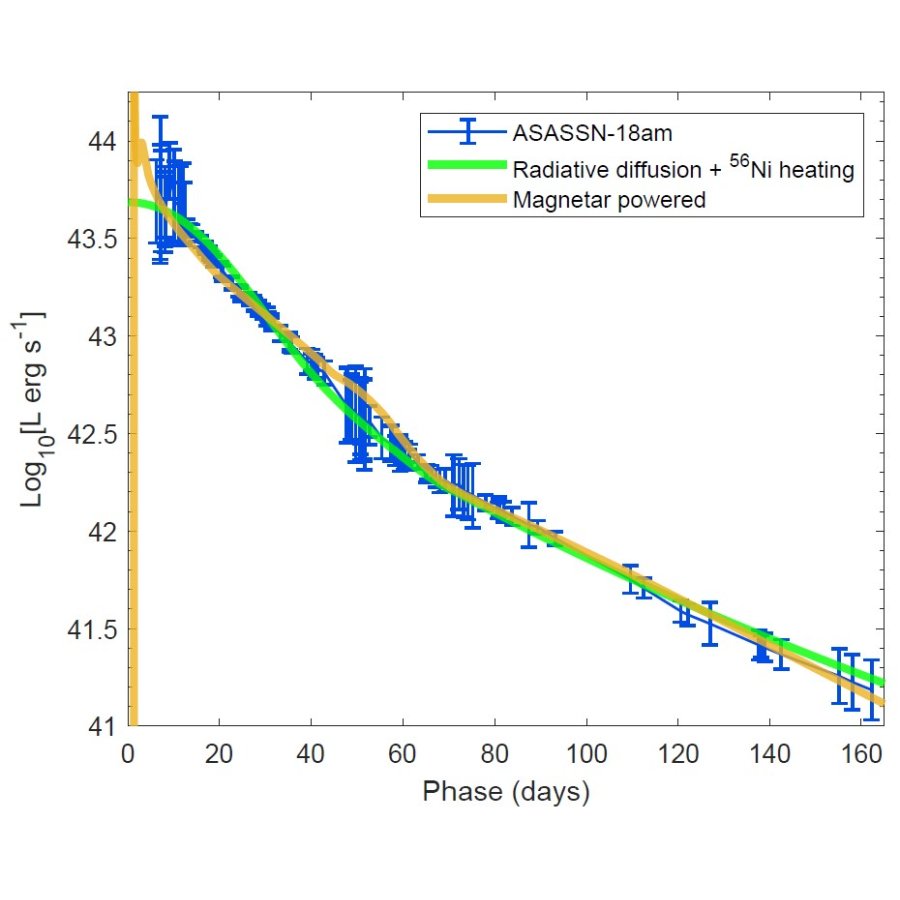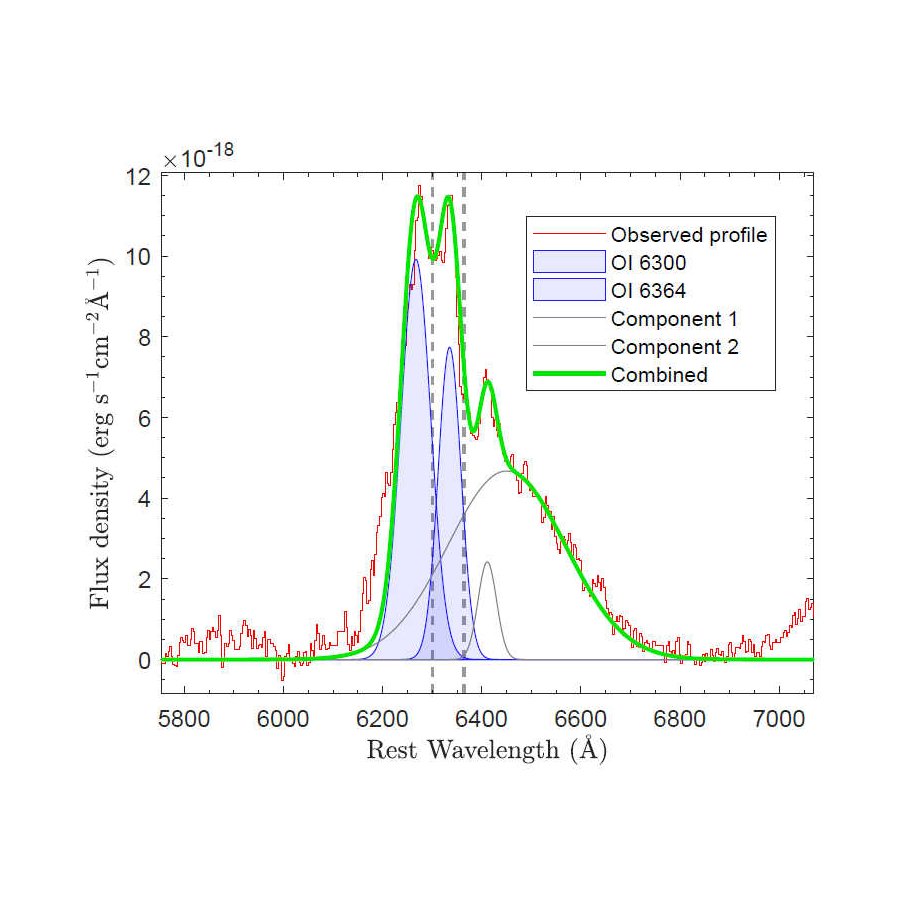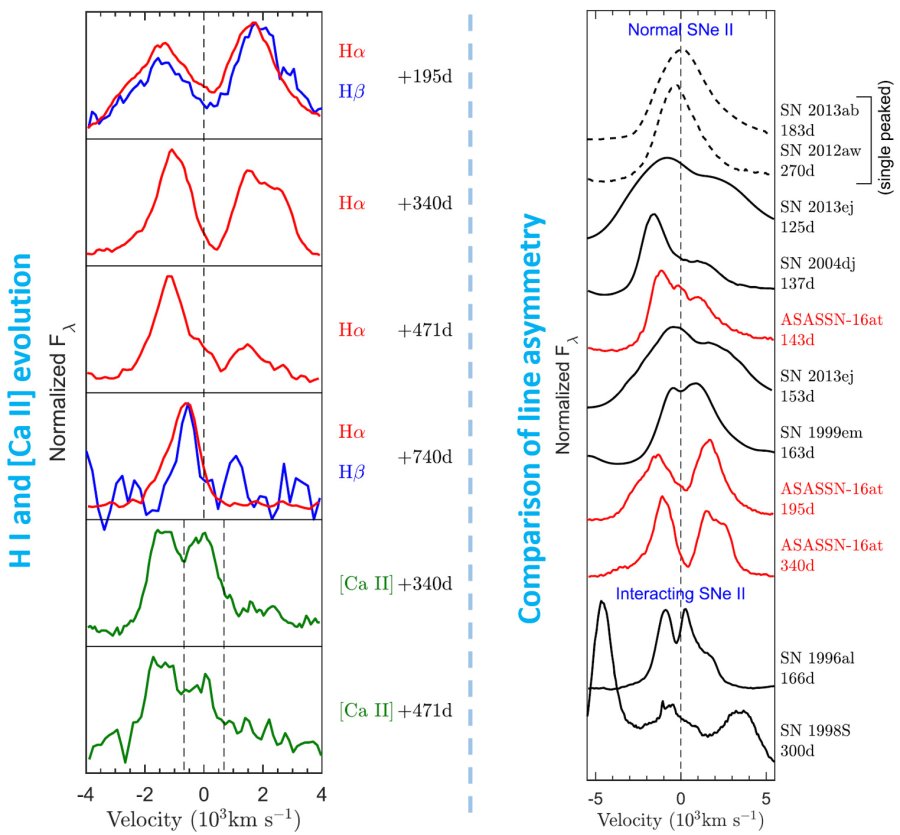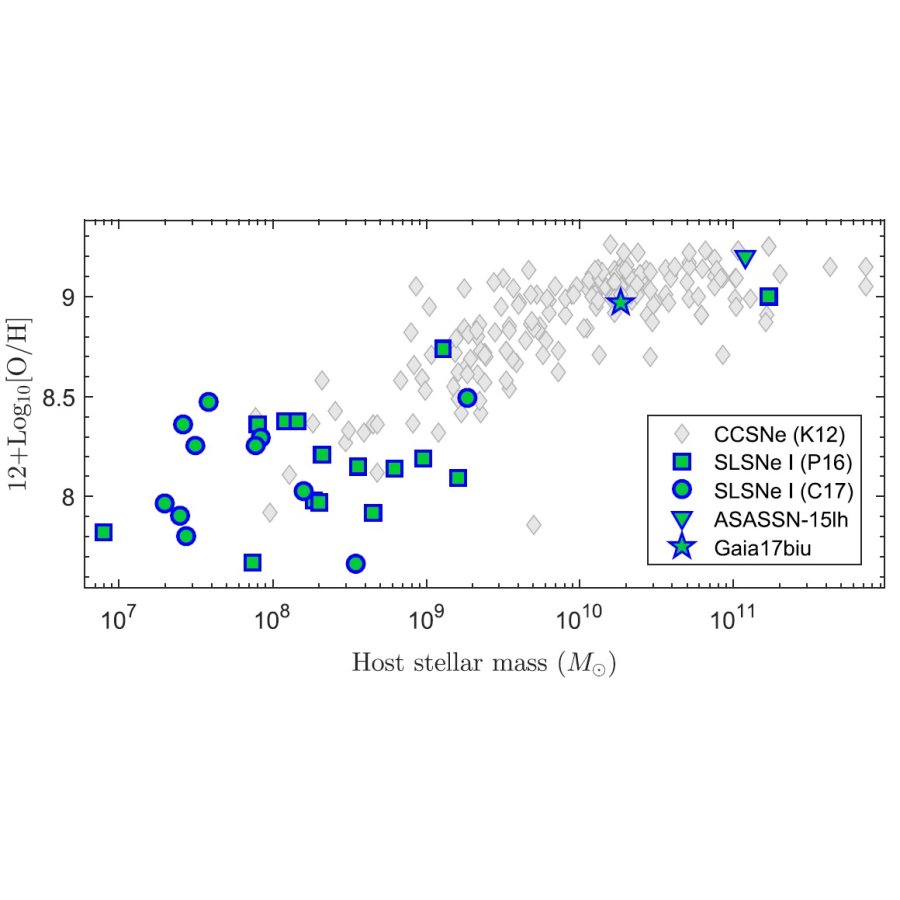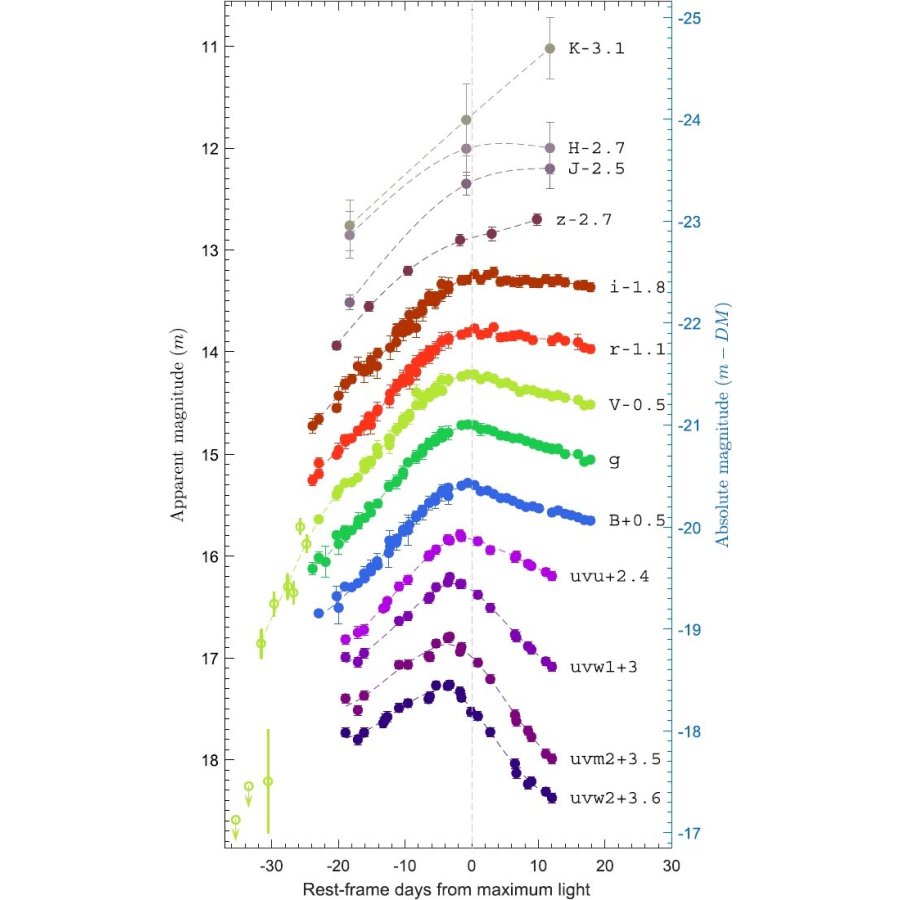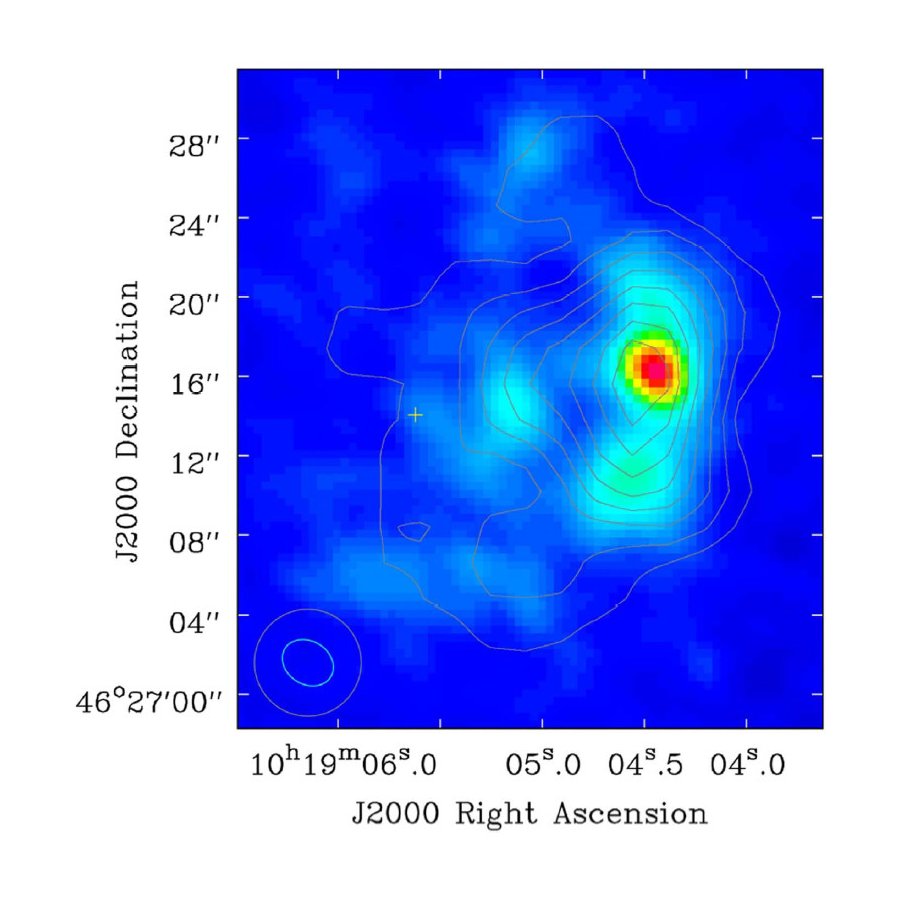Research Highlights
A 2003fg-like supernova in an apparent hostless environemnt
Bose, S. et al., 2025b, A&A, arXiv:2511.07529
SN 2021hem belongs to a rare group of Type Ia supernovae known as “2003fg-like” or sometimes referred as “super-Chandrasekhar” supernovae. These explosions typically shine unusually brightly and do not show the secondary peak in their near-infrared light curves that is common in normal Type Ia events. For SN 2021hem, the peak brightness in the B band reached an absolute magnitude of –20.0, significantly brighter than ordinary Type Ia supernovae.
In the earliest stages, a supernova’s atmosphere is expected to behave like an opaque, expanding “fireball,” producing a smooth, power-law increase in brightness. However, SN 2021hem showed an unexpected feature: its first detection occurred about 1.5 days before the onset of this expected fireball rise. Combined with its early color (measured from the g–r bands), this behavior cannot be explained by interaction with surrounding material or with a companion star. A more likely explanation is that radioactive \(\rm ^{56}Ni\) was mixed only shallowly—or distributed asymmetrically—within the ejecta. A double-detonation scenario involving a thin helium shell is also possible, though less favored.
Another intriguing aspect is the apparent absence of any host galaxy at the supernova’s position. Deep imaging with the 10-meter GTC telescope was used to search for a host. By performing a simulation of injecting artificial stars into the image and measuring its detectability, we determined a point-source limit of \(m_{lim,r}=24.4\) mag and a surface-brightness limit of \(\mu_{lim,r}=26.3\rm\,mag\,arsec^{-2}\). These limits are deep enough to rule out even extremely faint galaxies, including ultra-diffuse galaxies (UDGs), at the explosion site.
The closest cataloged galaxy is an active galactic nucleus (AGN), lies about 104 kpc from the supernova’s position. If this galaxy were the true host, the progenitor star (or binary system) would have had to travel that distance at an extraordinary speed of roughly 2200 km/s, making it a hyper-velocity runaway system ejected by interactions with the AGN. Another possibility is a faint diffuse feature detected about 6 kpc from the supernova, whose brightness is consistent with that of a UDG. However, its morphology and normalized distance (\(d_{DLR}\)) make it a host candidate of low probability.
A type Ia supernova defying luminosity calibration relations
Bose, S. et al., 2025a, A&A, 699, A169
Type Ia supernovae are well-established standard candles for cosmological distance measurements due to their known peak intrinsic brightness. This is possible because their peak luminosity correlates with the shape of their light curves, allowing for calibration using parameters such as the light-curve decline rate (\(\Delta m_{15}\)) and the color-stretch parameter (\(s_{BV}\)).
However, ASASSN-20jq (also known as SN 2020qxp) is a low-luminosity Type Ia supernova that stands out as a significant outlier in luminosity calibration relations based on either of these light-curve shape parameters, \(\Delta m_{15}\) or \(s_{BV}\) — behavior not previously observed in other Type Ia supernovae. Spectroscopic analysis reveals a marginal yet conclusive detection of the forbidden \(\rm [O\,I]\) \(\lambda\lambda6300,~6364\) doublet emission in its nebular spectra—an exceptionally rare feature for a Type Ia supernova. Additionally, both prominent nebular lines, namely the forbidden \(\rm [Ca\,II]\) and \(\rm [O\,I]\) emissions, are redshifted by approximately \(2000~\text{km s}^{-1}\). The supernova also exhibits a strong \(\rm [Fe\,II]\) \(\lambda7155\) emission line with a flat, tilted-top profile.
The asymmetric \(\rm [Fe\,II]\) line shape, combined with the redshifted \(\rm [Ca\,II]\) and \(\rm [O\,I]\) lines, suggests a high central-density white dwarf progenitor that underwent an off-center delayed-detonation explosion. This mechanism likely produced nearly equal amounts of \({}^{56}\text{Ni}\) during the deflagration and detonation phases. Assuming this scenario, we successfully modeled both the optical and near-infrared nebular spectra, achieving good agreement with the observations.
The light-curve and spectral characteristics of ASASSN-20jq do not fit neatly into any known subclass of Type Ia supernovae. Nonetheless, its marked deviation from the standard luminosity–light-curve shape relations, along with several photometric and spectroscopic properties, shows notable resemblance to some 2002es-like Type Ia supernovae.
An overly-luminous Type II supernova from a massive progenitor
Bose, S. et al., 2021, MNRAS, 503, 3472
ASASSN-18am (or SN 2018gk) is a newly discovered member of the rare group of luminous, hydrogen-rich supernovae (which we designate as LSNe-II) with a peak absolute magnitude of \(M_V \approx -20\) mag that is in between normal core-collapse SNe and superluminous SNe, which was also considered as a missing gap by some earlier studies. Only about five such supernovae have been identified so far, which also includes our previously discovered ASASSN-15nx (Bose, S. et al., 2018b, ApJ, 862, 107). The high intrinsic luminosity (without circumstellar interaction) of these supernovae makes it difficult or impossible to explain by widely accepted neutrino driven explosion mechanism. In this work, we examine various powering mechanisms, including radiative diffusion and magnetar spindown models. Both of these models required a high synthesized \(\rm ^{56}Ni\) mass \(M_{\rm Ni} \sim0.3-0.4\,\rm M_\odot\) and very high kinetic energy of ejecta \(E_{\rm kin}= (3-9)\times10^{51}\) erg. The high \(\rm ^{56}Ni\) mass is consistent with strong iron-group nebular lines present in nebular spectra. Again, these estimated parameters, especially the high \(\rm ^{56}Ni\) mass can not be produced in recent modeling attempts for neutrino driven explosions.
The earliest spectrum shows "flash ionisation" features, which is also for the first time in these kind of supernovae, from which we estimate a mass-loss rate of \(\dot{M}\approx 2\times10^{-4} \, \rm M_\odot\,yr^{-1}\) and a wind velocity \(\lt 100\,\rm km\,s^{-1}\). Using these wind properties along with detected X-ray luminosity, we infer that the wind density is too low to power the luminous light curve by circumstellar interaction. We measure ejecta expansion velocities as high as \(17,000~\rm km\,s^{-1}\) for \(H\alpha\), which is remarkably high compared to other supernovae. We estimate an oxygen core mass of \(1.8 - 3.4\, \rm M_\odot\) using the \(\rm [O\,I]\) luminosity measured from nebular spectrum, implying a progenitor with an uncommonly high zero-age main-sequence mass of \(19-26\,\rm M_\odot\), which is one of the most massive progenitor estimates for hydrogen-rich SNe.
A bipolar core in dust forming envelope of a Normal Type IIP Supernova
Bose, S. et al., 2019, ApJL, 873, L3
ASASSN-16at/2016X exhibited features of normal type IIP supernova during most of its evolution until the early tail phase (<150 days). However, the late nebular spectra (observed till 740 days) showed a unique double peaked \(\rm H\,I\) emission, where each component is symmetrically positioned about the rest wavelength. This bifurcation in the nebular line indicates strong bipolarity in the distribution of radioactive 56Ni or inner ejecta. Such a prominent double-peaked profile has not been observed before in any other supernova nebular spectra. Additionally, ASASSN-16at we find evidence of dust formation during late phases, which adequately explain the evolution of double-peaked nebular emission. As more dust being formed with time, the redder component of the double-peaked structure is seen to progressively diminishing due to differential extinction from dust. The strong and increasing near-infrared excess during the post-photospheric phase also supports the scenario of dust formation. This is one of the finest example which shows the importance of late time observations in core-collapse supernovae, even if they show normal characteristics during early phases.
Nearest Superluminous Supernova in a Massive Metal-rich galaxy
Bose, S. et al., 2018a, ApJ, 853, 57
Gaia17biu/2017egm, which we identified to be a hydrogen-poor Superluminous supernova (SLSN-I) in a record-breaking low redshift of z=0.03 (distance of 400 million light-years) which is one third the distance for any previously discovered SLSNe-I. Interestingly the SN was found in a massive and metal rich spiral galaxy (NGC 3191), unlike hosts of previously observed SLSNe-I. We estimated the host galaxy mass of \(1.6\times 10^{10}\rm\,M_\odot\) and the metallicity near the location of the SN is \(12+\rm log[O/H]\approx 8.9\) (roughly solar metallicity). The host galaxy of Gaia17biu, has a very unusually high mass and metallicity compared to other SLSN-I hosts, although its properties are typical of the general population of star-forming galaxies and the hosts of core-collapse SNe. The low redshift of Gaia17biu, and the relative deficiency of low redshift (z<0.05) SLSNe-I with dwarf hosts implies that any suppression of SLSN-I production in metal-rich and massive hosts is likely weaker than previously thought.
Having the advantage of close proximity and low line-of-sight extinction, obtained very detailed obervations which is unprecendented for SLSN-I. Data were obtained in photometric, spectroscopic and spectropolarimetric modes, and spanning a wide wavelength range including X-rays, near ultraviolet, optical, near infreared and radio bands.
